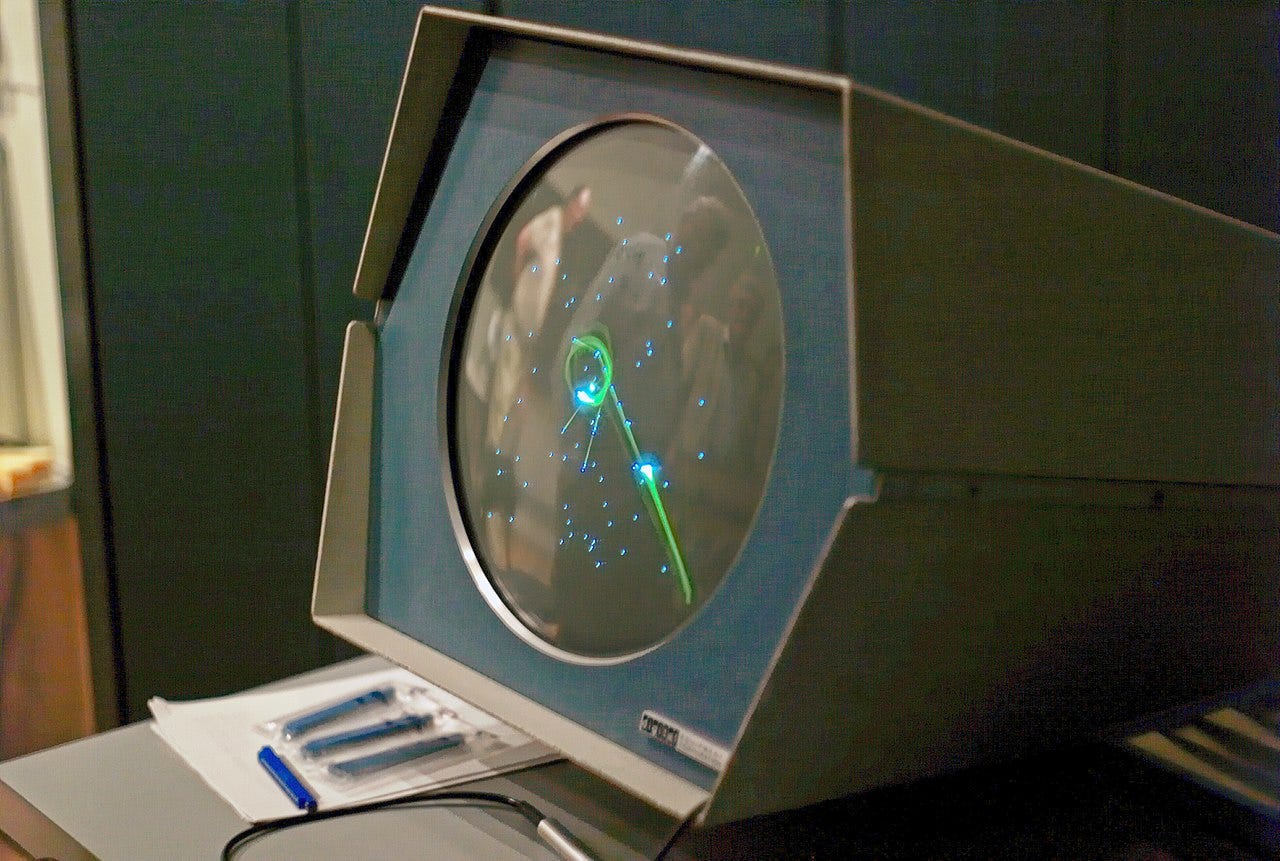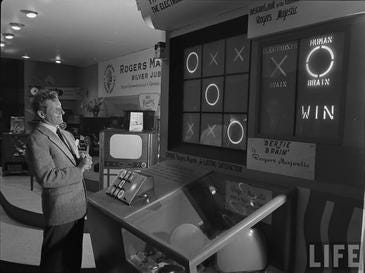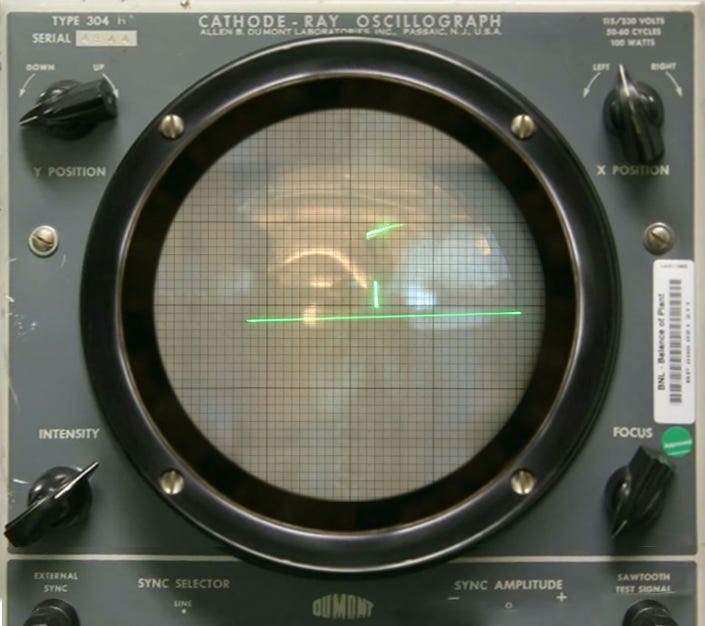The history of video games is as exciting as the games themselves. Because video games combine the technological advancements of computers and the imagery of television with the nostalgia of consumer goods, it’s hard not to be excited about even the minor details of their evolution. If you add in consumers’ personal experiences and the social trends video games have affected (or even created!), the story of video games becomes one of the grand narratives of technological history.
Even better, all of these strands are present from the beginning. Much like calculus, several inventors more or less came up with the idea for a video game in the same period (roughly 1958-1966). But, this wasn’t truly a case of ‘simultaneous invention’ as each of their ideas differed, emphasizing a different aspect of video games. All this makes figuring out who created the ‘first’ video game challenging but enjoyable.
The Usual Suspect
Ralph Bear is the person typically credited with the first video game. No less an expert than George W. Bush presented him with a medal as the ‘Father of Video Games’ in 2006. In fairness, this makes a lot of sense - Baer did create an early video game that became the first home console, giving him a direct line to the most tangible form of video games.
Baer’s story is incredible - a sort of archetypal American immigrant narrative. But I’ll save that for another post. Suffice it to say, Baer was a Jewish immigrant from Germany who, after serving in WWII and getting a degree in television, found himself leading a team of engineers to create airplane radars at a defense firm, Sanders Associates, in the 1950s.
According to his account, his ‘ah-ha’ moment occurred while waiting at a bus stop in 1966. At that time, there were over 40 million televisions in the US, and prices were falling. These televisions could only broadcast; audiences could not interact with them. While waiting for his bus in New York City, Baer began to wonder if there was not a way for audiences to play games on television. He created a disclosure document, now in the Smithsonian, outlining this idea and petitioned Sanders for money to develop it.
Sanders was not blown away but was willing to let him continue. By early 1967, Baer, along with Bill Harrison and Bill Rusch, developed a “chase” game, in which one dot was able to chase and “capture” another dot, as well as a second game in which a gun “shot” targets on the screen. By 1968, Baer could now play hockey, ping-pong (which became Pong), handball, soccer, and various other games.
From a technical standpoint, however, the team’s “TV Games,” as they called them, were still relatively primitive. It had no electronic chips, software, or microprocessors and did not even come with any sound or advanced graphics. Magnavox sold plastic overlays for the television screens to account for the lack of graphics offered by the basic software. But could it play games on television? Yes, yes, it could! And therefore, it deserves its place in the race for the ‘first’ video game.
Baer’s claim as the ‘Father’ of video games owes as much to his success commercializing the idea as his initial conception. “Brown box” in hand, Baer went to leading television producers to see if he could sell his contraption. RCA, Sylvania, GE, and Motorola all turned him down. Magnavox, however, was interested and agreed to an exclusive license in 1971, beginning production in 1972. In a foreshadowing of things to come, Magnavox refused to grant any other licenses (e.g., for games) but relied on discrete parts easily created by hobbyists. The predictable result was 15 years of lawsuits, most of which Magnavox would win, but all of which were painful.
Nonetheless, the ‘Odessey’ (Baer's creation's third and final name) was successful. By the end of 1972, over 100,000 Magnavox Odyssey’s had been sold at $100, beginning the U.S. home video game market. Sales would reach 450,000, total, by 1975, and likely would have been more had Magnavox not limited retail sales so heavily. 1975 was the last year for the Odessey, however, as Atari would release Pong, thereby creating a new chapter in the industry.
The Challenger
So is that it? Baer created the first video game. Well, no, not exactly. There is a second branch in the video game family tree, which comes earlier and more directly from the evolution of computers.
Without going through the whole history of computing, let me begin in the mid-1950s, at which point computing technology had advanced sufficiently in the wake of WWII that select colleges and universities (and even more select high schools, most notably Bill Gates’s high school) were starting to receive mainframe computers and allowing their students to work on them. Cambridge gave out its first computer science degree in 1953, with other elite colleges following suit. Momentum gathered in the US during the 1960s as the Kennedy Administration invested heavily in colleges and universities as part of the Cold War.
From the perspective of video games, these trends aligned at MIT in the early 1960s to create a “hacker culture” in which students regularly sought opportunities to develop and write their programs. The PDP-1, a mainframe computer that used cathode-ray tubes and a keyboard interface, had been donated by the Digital Equipment Company (DEC) and became an instant favorite among students for its ease of writing programs. With an 18-bit word size and (with some upgrades) memory equivalent to 65,356 words, the PDP-1 was roughly the equivalent of a pre-phone area planner (e.g., the Palm Pilot) but much heavier.
Amongst the “hacker” students were Steve Russell and J. Martin Graetz, who used the PDP-1 to create the game Spacewar! in 1962. (It’s interesting that the students had three years to write things before they wrote the first game. It appears they were very interested in word processors and other, more practical things. I will leave it to you as to whether that tells us more about the nature of innovation or generational differences). Spacewar! was a simple, black-and-white game (looking much like the later Asteroids for those familiar with early Windows games) in which two spaceships could chase each other across the screen and lob missiles at one another.
Creating the game took over 200 hours of programming, requiring screen overlays and the PDP-1’s toggle switches to steer. But, all this proved remarkably successful - so successful that MIT had to limit how many hours students could play it. By the 1970s, the game had spread beyond MIT to other universities and had been translated onto other systems as graduate students continued to enjoy the creation.
Spacewar!’s path to commercialization took a very different route than Baer’s ‘Brown Box,’ however. Russell would ultimately transfer to Stanford, where he would play the game for Nolan Bushnell, the famed founder of Atari. Bushnell would eventually use Spacewar! for his first game, creating an arcade version of it called Computer Space that would launch Atari.
Because of this, Spacewar!, though chronologically earlier than Odessy, has typically been considered the precursor to computer or arcade games, not video games proper. Today, that distinction seems more artificial as we see increased overlap. At the time, however, these two things seemed radically different.
The Missing Links
While the stories of Russell and Baer are the most common in books on video games, focusing on them misses over a decade of relevant developments. Games and computers have been closely linked since the formation of computers. As the (excellent) video game blog They Create World notes, computers began to exist in the 1940s (to oversimplify), and the first programs that could be called games followed in the 1950s.
Interestingly, these were typically created to show off the computers’ characteristics and abilities, not for the entertainment of audiences. One of the first such instances occurred in 1950 when Rogers Majestic (a Canadian vacuum tube manufacturer that would become Rogers Communications) made Bertie and the Brain. Bertie was designed explicitly by Rodgers to showcase the power of computers - and it certainly did! At 13 feet high, it towered over users attempting to play tic-tac-toe against the computer. While it seems to have been popular with users during the Canadian National Exhibit in 1950, it was dismantled shortly after that and never seen again.
Indeed, such stories are not uncommon in the 1950s. In Cambridge a couple of years later, math PhD Christopher Strauchy created a “noughts and crosses” game for a Turing machine, subsequently called OXO in Martin Campbell-Kelly’s history. As the 1950s played on, students continued to make versions of tic-tac-toe, checkers, and even chess on university mainframes. Yet, none of these seems to have been distributed outside their academic departments.
Tennis for Two is the very notable exception to this rule. This game, also called Computer Tennis, came out of the Brookhaven National Laboratory as a physicist, William Higinbotham, read through the Donner Model 30 computer manual and realized that an interactive game would help users experience the computer. Using the computer’s ability to simulate gravity and resistance, he built a game that allowed users to “hit” a “tennis ball” across a platform. He subsequently tweaked the game, enabling users to simulate gravity on Mars and the moon. But, even without these additions, the game was a hit! During an exhibition in 1959, “hundreds” lined up to play the game. But, as in the cases above, Computer Tennis was also dismantled after the 1959 exhibition to be used for parts.
Interestingly, Higinbotham did not pursue this further as he did not wish to be known for video games. Having led the electronics department at Los Alamos during WWII, he became very involved in anti-nuclear proliferation activities and preferred to maintain that as his legacy. He was forced to testify about video games in 1976, as Magnavox was being sued for not allowing developers to make games for its Oddessy. The goal was to prove that Tennis for Two was the first video game, and therefore, Magnavox had nothing to patent. But not surprisingly, this legal tactic did not work, allowing Higinbotham to return to his peaceful life as a physicist and activist.
Conclusion
So, who did create the first video game? The answer here is philosophical. Everything depends on what you mean by ‘video game’?
For my part, I find economists’ distinction between ‘innovation’ and ‘invention’ helpful. An ‘invention’ is a good idea that never gets commercialized. An ‘innovation’ is an idea that ultimately sells something. From this perspective, Baer becomes the clear winner, deserving his title of the “father of video games.” This is not to diminish the works of others; it is simply to point out that, on some level, history is written by the victors, and in economics, the victors are those who sell.







